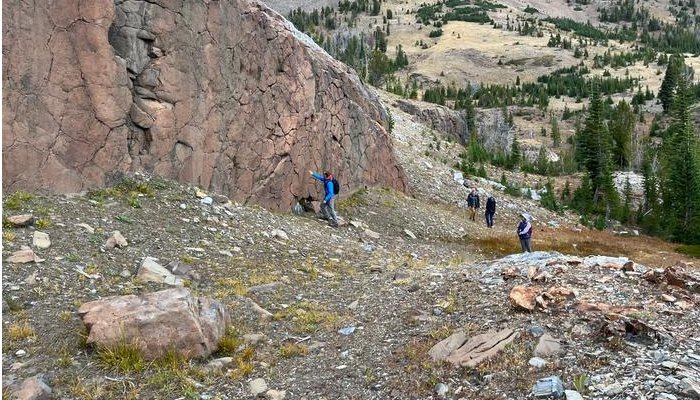Eddie Gonzales Jr. – MessageToEagle.com – An international team, led by a Rutgers University-New Brunswick volcanologist, found that ancient volcanoes emitted carbon dioxide into the atmosphere long after their eruptions had ended.
An international team of geoscientists journeyed to northeastern Oregon, where massive volcanism has been linked with climate warming 16 million years ago. For their study, the scientists zeroed in the Wallowa Mountains, which are laced with enormous sheets of flat magmatic dikes, created when molten rock flowed into cracks and solidified. Image credit: Benjamin Black/Rutgers University
In doing so, the research team has solved a long-standing mystery over what caused prolonged episodes of warming during turning points in Earth’s climate history. The work is detailed in the journal Nature Geoscience.
“Our findings are important because they identify a hidden source of CO2 to the atmosphere during moments in Earth’s past when climate has warmed abruptly and stayed warm much longer than we expected,” said Benjamin Black, who led the study and is an associate professor in the Department of Earth and Planetary Sciences at the School of Arts and Sciences.
“We think we have figured out an important piece of the puzzle for how Earth’s climate was disrupted, and perhaps just as importantly, how it recovered.”
In the present-day, humans are releasing vastly more carbon dioxide than all active volcanoes put together—but the new findings could shed light on how the planet’s climate will recover if and when human carbon dioxide emissions decrease. “Earth has natural climate control systems—sort of like the thermostat in your house,” Black said.
“The question is—are there thresholds beyond which those climate control systems start to break down, making it much harder for the climate to recover?”
For decades, scientists have been baffled by climate records showing the failure of the Earth’s atmosphere to recover as quickly as expected after what is known as the end-Permian mass extinction 252 million years ago—the most severe decrease in biodiversity known to have occurred on Earth.
The mass extinction has been linked with tremendous volcanic eruptions in Siberia. Even after the eruptions ceased, Earth’s climate took nearly 5 million years to stabilize.
“This delayed recovery has long puzzled scientists. Earth’s natural thermostat seems to have gone haywire during and after this event,” Black said. “We noticed that a similar pattern seemed to have occurred at multiple other times in Earth’s history with massive volcanism, and we set out to understand why.”
Black and an international team of colleagues looked back in time and found evidence for carbon dioxide emissions from this type of volcanic province that could last millions of years after most surface eruptions had ended. They did this by compiling chemical analyses of the lavas, developing computer models simulating melting inside the Earth, and comparing the results with records of past climate preserved in sedimentary rocks.
The analyses showed that massive ancient volcanic provinces shut down slowly. At the surface, eruptions may have stopped, but deep in the crust and mantle, magma was still releasing carbon dioxide, leading to prolonged climate warming.
“We call this CO2 from the subsurface magma ‘cryptic carbon’ because it comes from magmas lurking deep in the system,” Black said. “It’s as if the volcanoes were releasing carbon from beyond the grave.”
Black said the findings in the new study are significant because they identify a hidden source of atmospheric carbon dioxide during moments when the climate warmed abruptly. If the volcanoes kept “turning the temperature up,” it could mean the Earth’s thermostat may work better than scientists thought.
“If this is true, it could be good news for Earth’s recovery after human-driven climate warming,” Black said. “It means that if we stop turning the thermostat up, on geologic timescales, climate can recover.”
These findings are just the beginning of a multi-year effort to investigate how cryptic carbon could influence recovery after major disruptions of Earth’s climate. This summer, the team journeyed to northeastern Oregon, where massive volcanism has been linked with climate warming 16 million years ago.
The scientists zeroed in on the Wallowa Mountains, which are laced with enormous sheets of flat magmatic dikes, created when molten rock flowed into cracks and solidified. Because of erosion, the area known as the “Alps of Oregon” exposes these rocks that once constituted magma deep in the Earth.
Team members, including Black and colleagues and graduate students from Rutgers and other universities that are part of the team, clambered into the mountains, ranging between 5,000- and 9,000-feet high, and sampled the glass-like material at the edges of the dikes. These were created when magma came into contact with colder surrounding rocks.
Back at their labs, the researchers are looking for evidence in the glassy rocks of ancient emissions of carbon dioxide and other gases.
Source – news via Eurekalert
Written by Eddie Gonzales Jr. – MessageToEagle.com Staff Writer







